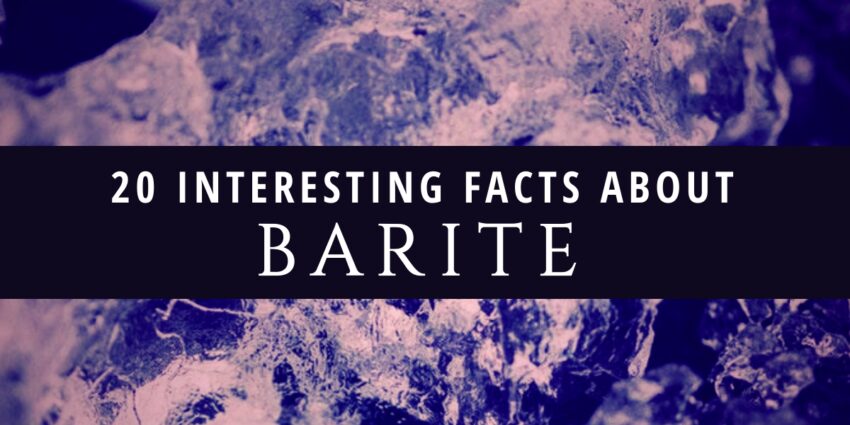The largest identified global resources of barite are found in the Qinling and Jiangnan regions of southern China and the Cuddapah district of India. In 2018, China was the largest producer of barite, by a large margin, followed by India and then Morocco. Meanwhile, dramatically increased consumption of barite shows U.S. high-grade reserves being depleted.
Global dependence on a limited number of countries for specific mineral commodities such as barite has lead numerous nations to classify this mineral as a sovereignty-essential and critical commodity. Considering that most barite used by the United States is imported, it cannot be disputed that trade wars and geopolitical tensions could limit the ability of the U.S. to secure necessary barite resources in the future.
Be sure to check out all other critical raw materials (CRMs), as well.
Beyond the basics above, what else should we know about barite? Check out the 20 interesting facts below!
- Vincenzo Casciarolo, a 17th-century Italian shoemaker with an interest in alchemy, first noticed barium in the form of unusual pebbles that glowed for years after exposure to heat. He thought that, perhaps, he might have discovered the philosopher’s stone, and named these pebbles “Bologna stones” after his hometown, Bologna, Italy. Unfortunately, these glowing pebbles were later determined to be barium sulfate (BaSO4).
- Investigating magnesium oxide in 1774, German chemist Carl Scheele found a new earth metal: “an earth differing from all earths hithero known.” He called this new metal “terra ponderosa”, which is Latin for “heavy earth”. A comparison was made with Casciarolo’s Bologna stone, and the two were found to contain the same substance – until this point, people believed Bologna stone was a compound of calcium.
- In 1783 English chemist William Withering prepared the English translation of Swedish chemist and naturalist Torbern Bergman’s mineralogy treatise, and, in recognition for his study of the properties of barium carbonate, this mineral was subsequently named witherite.
- Barium metal was isolated for the first time in 1808 by English chemist Sir Humphrey Davy at the Royal Institution in London. Davy followed the advice of Swedish chemist Jacob Berzelius, who had told him that barium sulfate could be decomposed by electrolysis.
- Barite used in drilling muds in the United States must meet specifications defined by the American Petroleum Institute (API). The primary specifications include specific gravity and composition. In the 1930s, the API set a specific gravity specification of 4.2 for barite used in drilling to ensure expected performance.
- Since 1970, the United States has become increasingly dependent on foreign barite imports to satisfy the drilling industry’s demand for drilling mud.
- In 1979, China emerged as a significant barite supplier for the United States by supplying about 212,000 t of barite or about 16 percent of total U.S. imports. This amount represented about 38 percent of China’s estimated production (approximately 550,000 t). At that time, China generated about 7 percent of world barite production, and the United States generated about 27 percent.
- No known systematic assessment of either U.S. or global barite resources has been conducted since the 1980s.
- In 2010, the American Petroleum Institute (API) added an additional specification for 4.1 specific gravity barite, partially in response to dwindling domestic reserves of higher specific gravity barite.
- U.S. barite import sources from 2014 to 2017 were as follows: China, 63%; India, 14%; Mexico, 11%; Morocco, 10%; and other, 2%.
- In May 2018, the U.S. Department of the Interior, in coordination with other executive branch agencies, published a list of 35 critical minerals (83 FR 23295), including barite. This list was developed to serve as an initial focus, pursuant to Executive Order 13817, ‘‘A Federal Strategy to Ensure Secure and Reliable Supplies of Critical Minerals” (82 FR 60835).
- Barium is found naturally only in combination with other elements because of its high level of reactivity. Barium is most commonly found combined with sulfate and carbonate, but can also form compounds with hydroxide, chloride, nitrate, chlorate, and other negative ions.
- About 0.05 percent of Earth’s crust is barium, making it the 17th most abundant element in the Earth’s crust.
- Barite has an orthorhombic crystal structure.
- Barite has an unusual combination of properties: high density, softness, and chemical inertness. Barite’s most desirable characteristic is its high specific gravity.
- The mineral’s name “barite” is in response to its high specific gravity, which is exceptional for a nonmetallic mineral – “barite” was derived from the Greek word “barus”, or “heavy”.
- Barite deposits can be divided into the following four main types: bedded-sedimentary; bedded-volcanic; vein, cavity-fill, and metasomatic; and residual.
- More than 90% of the barite sold in the United States was used as a weighting agent in fluids used in the drilling of oil and natural gas wells. In fact. drilling rig counts have historically been an effective barometer of barite consumption.
- Barite is the only mineral used in substantial tonnages to increase the density of water-based drilling muds. Drilling muds prevent the explosive release of gas and oil during drilling, lubricate bit and drill stems, remove rock chips, prevent collapse of well walls, and prevent blowouts if overpressured strata are encountered.
- Barite is used as a filler, extender, or weighting agent in products such as paints, plastics, and rubber. Because barite significantly blocks x-ray and gamma-ray emissions, it is used as aggregate in high-density concrete for radiation shielding around x-ray units in hospitals, nuclear power plants, and university nuclear research facilities.
